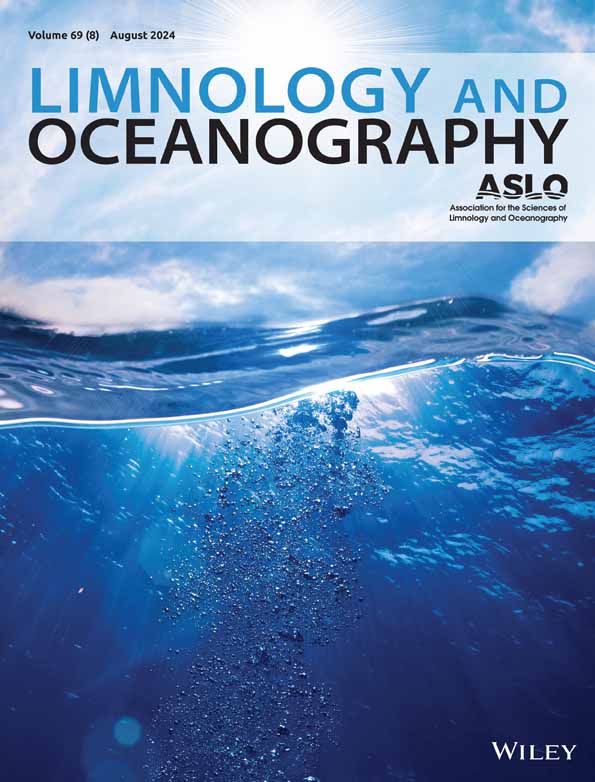马里亚纳海沟深海-浅滩过渡带沉积物深度依赖性真菌群落和生物地球化学潜力
IF 3.7
1区 地球科学
Q1 LIMNOLOGY
引用次数: 0
摘要
马里亚纳海沟是世界上最深的深海海沟。迄今为止,我们对马里亚纳海沟生物圈真菌代谢和生物地球化学循环的认识与原核生物相比非常有限。本文在马里亚纳海沟深海-浅海过渡带8个测点采集了表层0-6 cm、中层6-12 cm和深层12-18 cm 3层沉积物岩心,利用宏基因组学方法研究了沉积物真菌群落和生物地球化学潜力。共检测到8个真菌门,其中以子囊菌门最多,其次是毛菌门和担子菌门,还有独特的代表微孢子虫门和罗氏菌门(隐菌门)。在马里亚纳海沟深-潜过渡带南坡和北坡之间,真菌群落和碳、硫、氮的生物地球化学势在不同沉积层的精细尺度上存在差异,而在南坡和北坡之间没有明显差异。特别是,基于真菌宏基因组,强调了同化硫酸盐还原(ASR)途径,包括sat和cysI, cysC/PAPSS催化过程,以及NIT‐6将亚硝酸盐还原为氨。这些结果表明了沉积物深度依赖的真菌群落和生物地球化学潜力,为马里亚纳海沟中不太为人所知的真菌微生物群,特别是来自原核生物的真菌不同途径提供了新的见解。本文章由计算机程序翻译,如有差异,请以英文原文为准。
Sediment depth–dependent fungal community and biogeochemical potentials along the abyssal–hadal transition zone of the Mariana Trench
The Mariana Trench is the deepest of the world's deep‐sea trenches. To date, our knowledge of the fungal metabolism and biogeochemical cycles in the Mariana Trench biosphere is very limited compared with the Mariana Trench prokaryotes. Here, we collected the sediment cores from three layers (surficial 0–6 cm, intermediate 6–12 cm, and deep 12–18 cm) at eight stations in the abyssal–hadal transition zone of the Mariana Trench to investigate the sediment fungal community and biogeochemical potentials using metagenomics. Eight fungal phyla were detected, with Ascomycota being the most abundant, followed by Mucoromycota and Basidiomycota, along with the unique representatives Microsporidia and Rozellomycota (Cryptomycota). Distinct fungal community and biogeochemical potentials of carbon, sulfur, and nitrogen in the fine scale of the different sediment layers were revealed, while no obvious difference was detected between the southern and northern slopes of the abyssal–hadal transition zone of the Mariana Trench. In particular, the assimilatory sulfate reduction (ASR) pathway, including sat and cysI , cysC/PAPSS catalytic processes, as well as the dissimilatory nitrite reduction to ammonia by NIT‐6 , were highlighted based on the fungal metagenome. These results suggest sediment depth–dependent fungal community and biogeochemical potentials, providing novel insights into the less well‐known fungal microbiome in the Mariana Trench, particularly fungal different pathways from prokaryotes.
求助全文
通过发布文献求助,成功后即可免费获取论文全文。
去求助
来源期刊

Limnology and Oceanography
地学-海洋学
CiteScore
8.80
自引率
6.70%
发文量
254
审稿时长
3 months
期刊介绍:
Limnology and Oceanography (L&O; print ISSN 0024-3590, online ISSN 1939-5590) publishes original articles, including scholarly reviews, about all aspects of limnology and oceanography. The journal''s unifying theme is the understanding of aquatic systems. Submissions are judged on the originality of their data, interpretations, and ideas, and on the degree to which they can be generalized beyond the particular aquatic system examined. Laboratory and modeling studies must demonstrate relevance to field environments; typically this means that they are bolstered by substantial "real-world" data. Few purely theoretical or purely empirical papers are accepted for review.
 求助内容:
求助内容: 应助结果提醒方式:
应助结果提醒方式:


